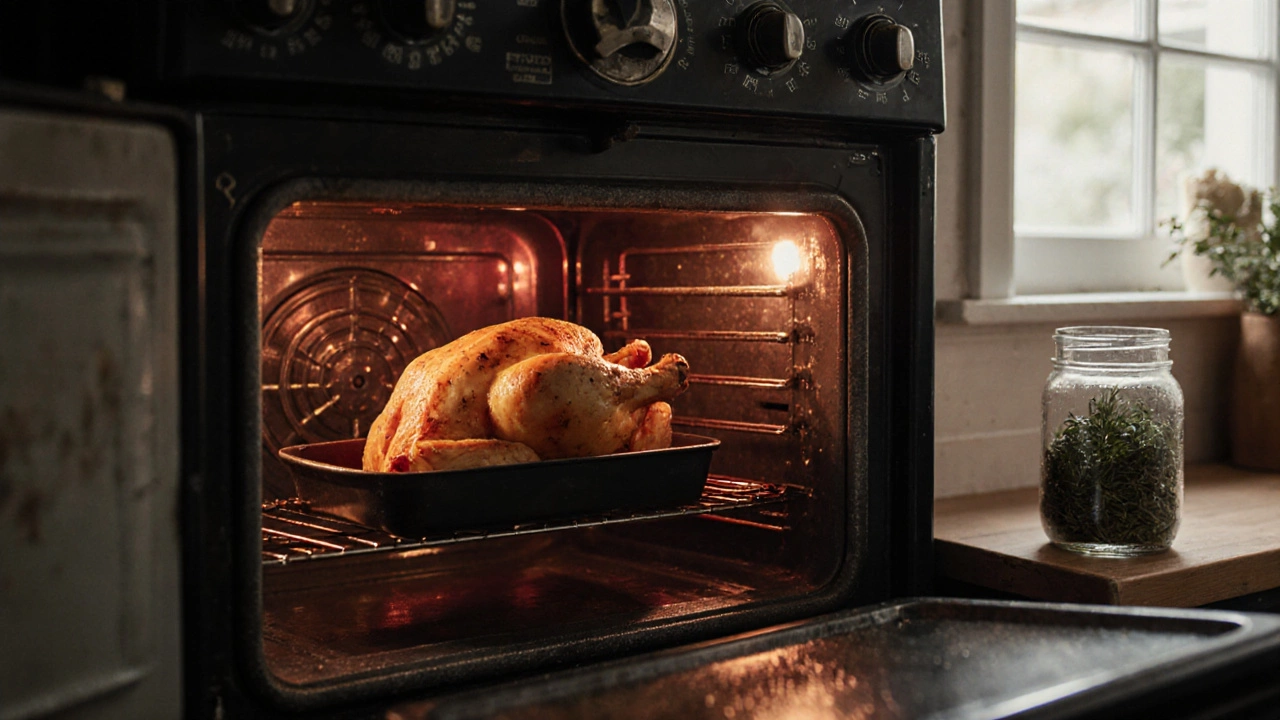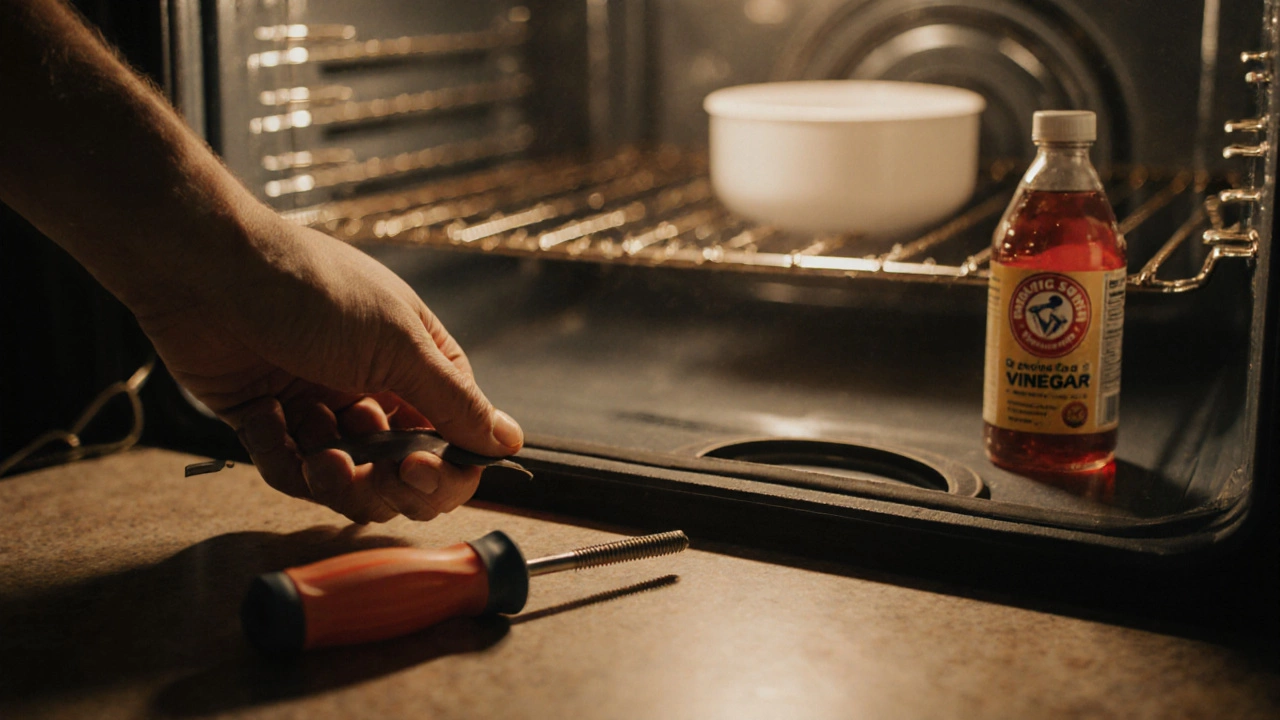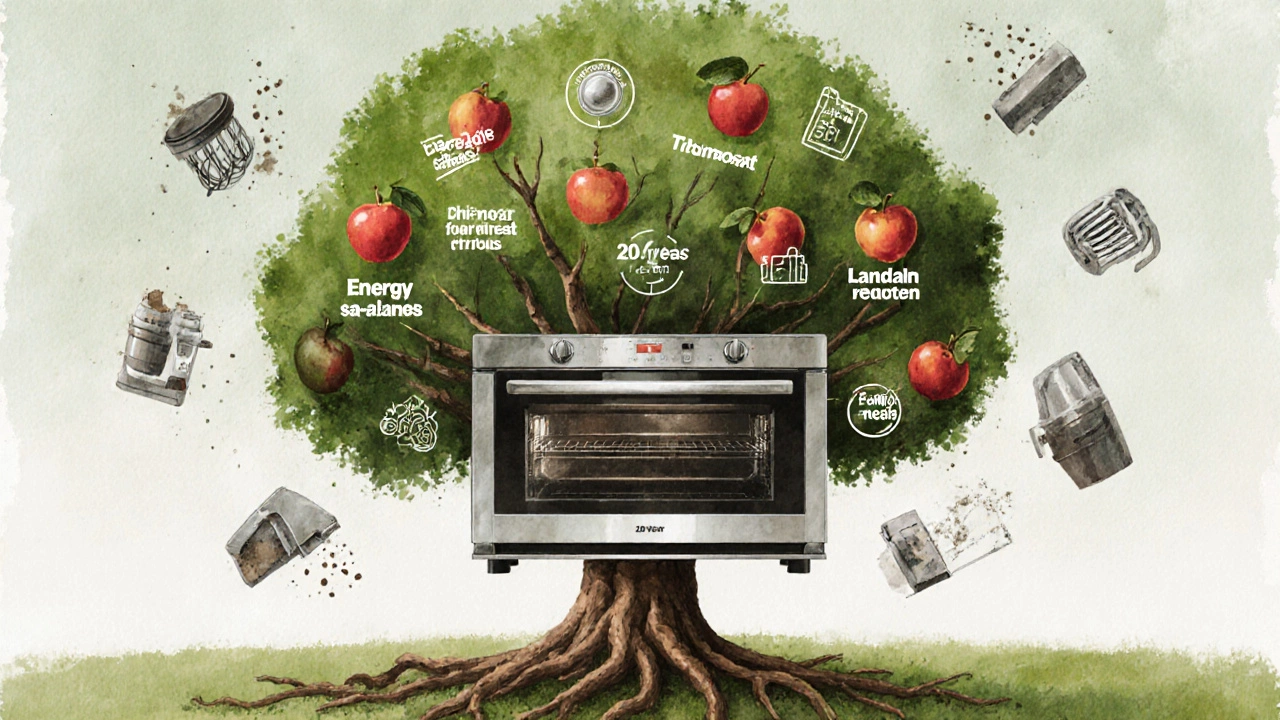
- 28 Oct 2025
- Gideon Thornton
- 0
Oven Repair Cost Calculator
Most people assume their oven will die after 10 years. But I’ve seen ovens in Bristol homes that are 25 years old and still baking perfect roasts. The question isn’t whether an oven can last 20 years-it’s whether you’re willing to treat it right. The truth is, many modern ovens are built to fail early. But older models, and even some newer ones, can easily hit two decades with the right care.
What Makes an Oven Last?
Not all ovens are created equal. A 2020 Consumer Reports study found that ovens with simple mechanical controls and solid steel interiors lasted 30% longer than those with touchscreens and plastic trim. The key factors? Build quality, repairability, and usage habits.
Brands like Miele, Bosh, and older GE models often use heavy-gauge steel, ceramic heating elements, and replaceable door seals. These aren’t flashy features, but they’re the ones that keep things running. Modern ovens, on the other hand, often glue parts together, embed circuit boards in hard-to-reach spots, and use plastic components that crack under heat.
One homeowner in Clifton replaced her oven’s heating element at age 18. The part cost £45. The new oven she was quoted? £900. She kept cooking. That’s the difference between a machine designed to be fixed and one designed to be replaced.
Signs Your Oven Is Still Worth Repairing
Just because your oven is old doesn’t mean it’s done. Here’s what to look for:
- Heating evenly? Even if it takes a few extra minutes, that’s fine. Uneven heating means a failing element or thermostat.
- Does the door seal close tightly? A cracked or brittle seal lets heat escape. Replacing it costs under £20 and takes 20 minutes.
- Are the controls responsive? Flickering lights or unresponsive buttons often mean a cheap control board. Those can be swapped out for £60-£120.
- Is there rust inside the cavity? Light surface rust can be sanded off. Deep rust eating through metal? That’s the end.
- Does it still heat to the right temperature? Use an oven thermometer. If it’s off by more than 25°F, the thermostat or sensor needs replacing.
One thing I’ve noticed working in Bristol homes: people panic when the self-cleaning function stops working. That’s not a dealbreaker. It’s a convenience feature, not a core function. Your oven can still bake, roast, and broil just fine without it.
How to Extend Your Oven’s Life
Simple habits make a huge difference. Here’s what actually works:
- Clean spills immediately. Burnt-on food creates heat traps that stress the element and insulation.
- Don’t use abrasive cleaners. Steel wool or harsh chemicals eat away at enamel coatings. Warm soapy water and a soft sponge are all you need.
- Check the door seal twice a year. Run a piece of paper around the edge. If it pulls out easily, the seal is worn.
- Let the oven cool before cleaning. Thermal shock from cold water on hot metal can crack ceramic elements.
- Don’t overload the racks. Excess weight strains the internal supports and can warp the cavity.
One woman in Bedminster cleaned her oven with vinegar and baking soda every month for 22 years. Her oven still works. No fancy gadgets. Just consistency.

When Repair Isn’t Worth It
There are times when replacing is smarter. Here’s when to walk away:
- The cavity is rusted through-especially near the bottom or around the heating element mounts.
- The control board is custom-made and no longer available. Many brands stop making parts after 7-10 years.
- Multiple major components are failing at once. Replacing the element, thermostat, and fan motor? You’re spending 60% of a new oven’s price.
- Your energy bills have jumped 30% in the last two years. Older ovens aren’t as efficient. A modern model could save you £80-£120 a year.
Don’t fall for the myth that all new ovens are better. Many budget models today have shorter lifespans than 1990s appliances. But if you’re paying over £1,000 for a new oven, it should come with a 5-year warranty and replaceable parts. Otherwise, you’re overpaying.
Real Repair Costs vs. Replacement
Here’s a quick breakdown of what you might pay in the UK in 2025:
| Issue | Repair Cost | New Oven (Entry-Level) | New Oven (Mid-Range) |
|---|---|---|---|
| Heating Element | £45-£75 | £400-£600 | £800-£1,200 |
| Thermostat/Sensor | £60-£90 | £400-£600 | £800-£1,200 |
| Door Seal | £15-£25 | £400-£600 | £800-£1,200 |
| Control Board | £100-£150 | £400-£600 | £800-£1,200 |
| Convection Fan | £80-£120 | £400-£600 | £800-£1,200 |
Notice something? Even if you need two repairs, you’re still saving hundreds. And if you can find a local technician who stocks common parts, you’re not stuck waiting weeks for a delivery.

Where to Find Parts and Help
Don’t go to the big-box stores for oven parts. They sell cheap knockoffs. Instead:
- Search for your oven’s model number on Appliance Parts Pros or UK Appliance Spares.
- Look for OEM (Original Equipment Manufacturer) parts-they’re made by the same company that built your oven.
- YouTube has step-by-step videos for most common repairs. Search: “replace heating element [your brand] [model number].”
- Local appliance repair shops often have bins of used parts from decommissioned ovens. Ask if they have a “core bin.”
I once helped a customer in Totterdown fix her 1998 Bosh oven with a £35 part from a local repair shop. The part had been pulled from a broken oven in a skip. It worked perfectly for another 7 years.
Is It Worth the Effort?
Fixing an old oven takes time. It might mean waiting for a part, learning how to disconnect the power, or wrestling with stubborn screws. But it’s not just about money.
Every oven you repair is one less appliance in a landfill. It’s one less carbon footprint from manufacturing, shipping, and disposal. And it’s one less reason to feel like you’re trapped in a cycle of buying and throwing away.
Some people say, “It’s just an oven.” But if it’s still cooking your meals, heating your home, and serving your family after 20 years-it’s not just an appliance. It’s a tool that’s earned its place.
Can an electric oven really last 20 years?
Yes, absolutely. Many ovens from the 1990s and early 2000s are still working today. What matters is build quality, regular maintenance, and timely repairs. Ovens with replaceable parts and simple controls tend to last longer than modern ones with glued-in electronics and plastic components.
What’s the average lifespan of a modern electric oven?
Most modern electric ovens last between 10 and 15 years. Cheaper models often fail sooner due to low-quality materials and non-repairable designs. Higher-end brands like Miele or built-in models with modular parts can exceed 20 years if maintained.
Is it cheaper to repair or replace a 15-year-old oven?
If the issue is a single component like a heating element, thermostat, or door seal, repairing is almost always cheaper. Replacing two or more major parts might push you close to the cost of a new oven. But even then, you’re still saving hundreds unless the cavity is rusted or parts are unavailable.
What parts of an oven are most likely to fail?
The heating element, door seal, thermostat, and control board are the top failure points. The element wears out from repeated heating cycles. Door seals harden and crack over time. Thermostats lose accuracy. Control boards fail due to heat and moisture. All of these are repairable.
How do I know if my oven’s cavity is too damaged to fix?
If you see rust that’s eaten through the metal-especially around the heating element mounts or the bottom panel-it’s time to replace. Surface rust can be cleaned, but structural rust means heat is escaping and the oven is unsafe. Test it: press on the rusted area with a screwdriver. If it dents easily, replace it.
Should I replace my oven if it’s not energy efficient?
If your energy bills have jumped 30% or more in the last two years, upgrading might save you money over time. Modern ovens are 15-20% more efficient. But if your oven still heats properly and you don’t use it constantly, repairing it and accepting slightly higher bills is still a sustainable choice.



